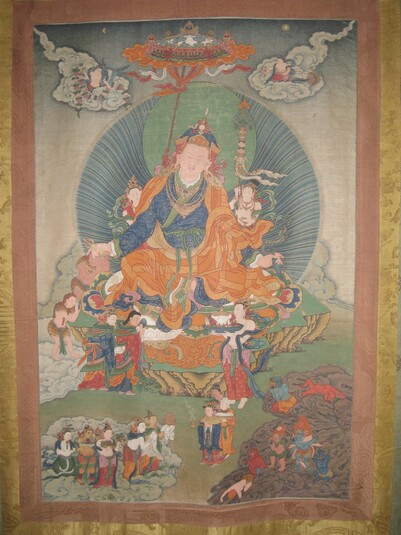
Item: Padmasambhava
| Origin Location | Tibet |
|---|---|
| Date Range | 1800 - 1899 |
| Lineages | Nyingma and Buddhist |
| Material | Ground Mineral Pigment on Cotton |
| Collection | Private |
Classification: Deity
Padmasambhava, as Guru Dupung Zilnon (gu ru bdud dpung zil gnon) is possibly related to the Vajrakilaya practices of Jigme Lingpa called Purba Dupung Zilnon (phurba bdud dpung zil gnon).

Note the unique form of the posture with the right hand holding a vajra extended outward to the side in a gesture of blessing above the heads of demons. The left hand holds a purba peg extended outward to the side and pointing downward subduing the demons below.
This extremely fine painting can be dated stylistically to the early 19th century and created in a Kham-dri style similar to the Khampa Gar painters of that time. It is not clear from the inscription on the back of the brocade (top), or the iconographic subject on the front, if the painting is a single composition or part of a related series (set) of paintings. Although one other painting with a different iconographic subject but the same stylistic elements, brush strokes and colour palette has been identified. See the painting of Shakyamuni Buddha and the Defeat of Mara.
Jeff Watt 10-2009
Front of Painting
English Translation of Inscription: [No inscriptions on the front]
Collection of Rock Mountain Sanctuary: Painting Masterworks
Padmasambhava: Painting Masterworks
Padmasambhava: 'Revealed Treasure'
Padmasambhava Main Page
Padmasambhava: Main Form (Vajra at the Knee)
Padmasambhava: Specialty Iconographic Forms





